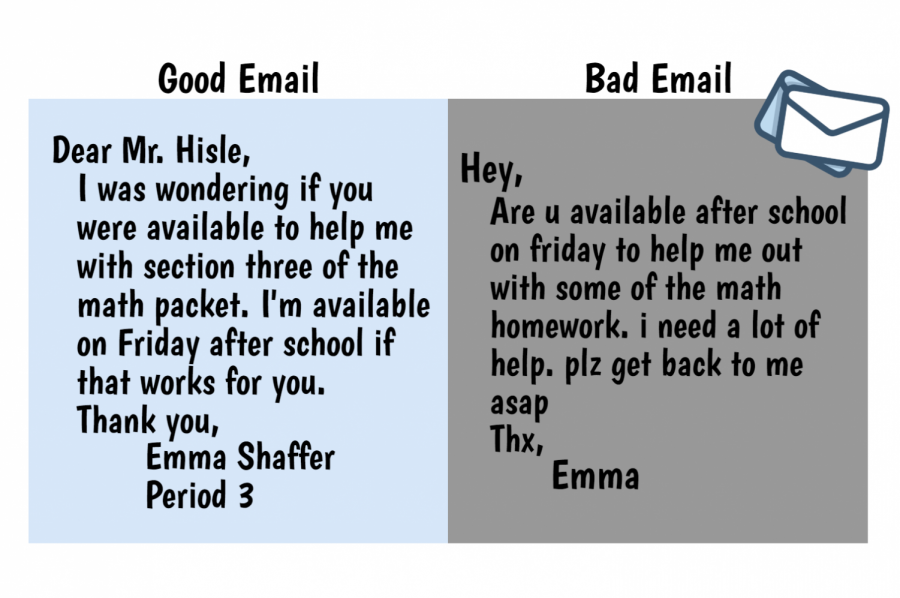How to write an email to your teacher
June 2, 2018
The mouse cursor hovers over the send button as a sophomore girl rereads her email: “Can u help me at lunch tmrrw?” She hits send and waits for a response. Later that day, while scrolling through his inbox, her teacher rolls his eyes at yet another unprofessional, one sentence email.
A well-worded email could substantially increase your chances of getting that grade bump, extension or opportunity for make-up work. One riddled with slang and abbreviations, however, could do the opposite.
Teachers often receive emails that are sloppily written or missing important information, which hurts their ability or willingness to help the student, history teacher Katherine Young said. Students: keep your audience in mind.
After talking to five Whitman teachers, The Black & White compiled these tips to help students write better, more effective emails to teachers.
Tip #1: Be respectful
The most important thing to remember in email writing is to be professional and respectful. Teachers are taking time out of their day to read and answer your emails, so thank them for extending their duties outside of the classroom. Ask rather than demand. Always begin your email by greeting your teacher. Then, write a brief comment, such as “hope your day is going well.” By doing this, you create a stronger interaction between you and your teacher, just as you would in person.
Emails that simply jump into what a student needs are very unprofessional, Young said. Just asking a straightforward question isn’t enough, especially if you’re asking a favor.
Tip #2: Always include your name
Including your name and class period in the email helps the teacher identify who you are, making it easier to respond.
Many student emails don’t formally address the teacher at the beginning or use a signature at the end, making it hard to tell who the email is from, especially when students use email addresses that don’t indicate the sender’s name.
Tip #3: Drop the text lingo
Ensure your message comes across clearly by using proper grammar and spelling. You may text your friend in incomplete sentences or shorthand, but that style of writing has no business going to teachers.
Never use slang or text lingo while writing an email. For example, spell out the word “you” instead of “u” and say “thank you” instead of “thx.” By doing this, you demonstrate respect for your teacher.
When a student isn’t clear in their email, it makes it difficult for teacher to understand what the student needs and how to help them, said engineering teacher Rachel Stender.
Tip #4: Know when to talk to your teacher in person
While sending an email to a teacher is sometimes more practical due to time constraints, many teachers do prefer an in person meeting. More serious conversations should always be discussed in person, math teacher Ralph Hisle said. However, an email can still be helpful for setting up these conversations.
Some teachers don’t appreciate when students ask for big favors, such as a grade bump, over email. When asking a teacher to bump your grade—which they’re under no obligation to do— talk to them politely in person, Stender said.
Todd Michaels, an English teacher, is known for his strict policy against grade bump emails.
“There’s a kind of email that I find insulting, which is a student thinks they deserve a certain grade, and it doesn’t matter what I think as the teacher,” Michaels said.
Tip #5: Check your inbox for a response
After you’ve emailed your teacher, remember to check your inbox frequently. If a teacher takes the time to email you back, check, read, and follow up with them.
Teachers may send casual email responses which could make you think formalities are unnecessary, but it can never hurt to be respectful in your writing.
“People can pass judgment on you based on how you express yourself in writing,” Young said. “I think it’s just really a good life skill to learn.”












BALLER • Aug 15, 2023 at 6:13 pm
baller
!!!!!!!!
jackson stein • Oct 6, 2022 at 1:06 pm
wow really good!
arravs big toe • Oct 6, 2022 at 1:05 pm
ayo stop deleting my comments and give me mod
thispersondoesnotexist • Jan 31, 2024 at 10:14 pm
101001010001010100101010111100100110010101010101010
B word • Oct 6, 2022 at 1:02 pm
Lg
arravs big toe • Oct 6, 2022 at 12:59 pm
i am arravs ig toe
arravs big toe • Oct 6, 2022 at 1:02 pm
i need mod real quick
garfeild • Oct 6, 2022 at 12:56 pm
big man
B word • Oct 6, 2022 at 12:49 pm
L
Aarav Bhatia • Oct 3, 2022 at 1:14 pm
Thanks this really helps!
Jake • Oct 3, 2022 at 1:10 pm
This is realy helpful thank you
joey • Sep 1, 2022 at 9:57 am
hi
Alex • Aug 24, 2022 at 11:09 am
Hello Mr. Beam
I would like some extra credit.
-Alex
Natalyah • Aug 19, 2021 at 12:39 pm
Good morning Mr.Gillizer
I hope you are having a wonderful day
Davin Morris • Aug 16, 2021 at 8:42 am
I still need to learn Spanish I am okay now but i need to improve
yara gallegos • Nov 10, 2020 at 10:27 am
I think that I still need to learn English and I think that little by little I am going to catch it and that in some classes it is very difficult for me …
Harrison Michael Miller • Oct 23, 2020 at 9:00 am
My favorite knife cut is chop.
Harrison Michael Miller • Oct 23, 2020 at 8:47 am
The mail that I need to do is perfect
jennifer • Oct 7, 2020 at 10:54 am
dear mrs beer.
i really enjoy the self portrait that you assigned for us all,also i really enjoy when you let
us listen to music when were working,
from:rayvin
kenya • Sep 14, 2020 at 10:00 am
This was very helpful.,this kinda makes me wanna use big words
kenya • Sep 14, 2020 at 9:59 am
This was very helpful.
Janelle Blanco • Aug 28, 2020 at 4:21 pm
Hello Ms. Salome
I want to tell you some things about me.
My favorite color is Pink
My favorite food is spaghetti
In my free time I like to paint and watch Tiktoks
I hope you enjoyed reading some stuff about me
Sincerely,
Janelle Blanco.
hot guy • Oct 6, 2022 at 1:04 pm
lemme get that number girllll
Genessis Orozco • Aug 27, 2020 at 2:17 pm
These tips are really helpful for me thank you.
andrew • Aug 19, 2020 at 4:36 pm
black and white are still people
Leo Canchola • Apr 27, 2020 at 2:51 pm
Getting this homework done
Graham Soofer • Jun 3, 2018 at 11:11 pm
I think this was very informative and helpful. I do believe that this entire article was plagiarized and this student should be expelled. An awful showing of academics. Shame on the teachers.
B word • Oct 3, 2022 at 1:13 pm
L
big man • Oct 6, 2022 at 1:03 pm
ong